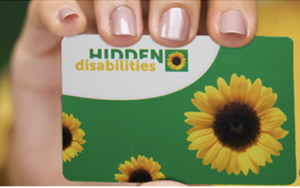Travelling with Home Mechanical Ventilation – Air Travel Guidance
For patients using home mechanical ventilation, airline travel carries significantly increased risk, and careful planning is essential.
Assessment (which may involve a hypoxic challenge test) is recommended to understand whether supplementary oxygen is required during flight. For those already established on long-term oxygen therapy at home, a higher oxygen flow rate during the flight may be indicated. However, due to the reduced oxygen concentration at altitude, even those who do not usually have oxygen as part of their treatment, may still require it during flight. This will all be part of the assessment undertaken prior to travel.
 Hidden Disabilities Sunflower: Help when travelling if your condition isn’t obvious
Hidden Disabilities Sunflower: Help when travelling if your condition isn’t obvious
Airline Travel and Home Ventilation Patients: Things to Consider
This video is essential viewing for HMV users preparing for airline travel.
Didi’s Story:
Didi has a spinal cord injury but this doesn’t stop her from enjoying travel. Here she shares her tips for overcoming the challenges.
Cath’s Story:
Cath who has Spinal Muscular Atrophy has travelled extensively, literally to the other side of the world! Here she shares some valuable tips for other HMV users looking to travel.
Advice from your clinical team may be necessary to support the carriage and use of NIV during the flight if required. Using oxygen and NIV at the same time is less straightforward, due to the way the equipment operates. This should all be discussed with your clinical team, as the airline will require the completion of a medical information form from a medical professional.
Other considerations include previous travel history, current clinical condition and the presence or absence of overnight travel in the journey itinerary.
Hints and tips for travelling with Home Mechanical Ventilation:
- Take daytime, short-haul flights where possible, and remain awake during the flight.
- Maximise the use of your non-invasive ventilation prior to and following each element of your journey.
- If NIV is recommended during flight, this will need to be illustrated on the medical form, and the airline may require technical specification information of the devices and batteries – discuss this with your clinical team.
- It is recommended that all medical devices (ventilators) are carried as hand luggage to avoid the risk of them getting lost or broken. A supporting letter from your clinical team may be required.
- Consider how these will be carried at the airport (eg a suitcase on wheels is more helpful than a shoulder strap bag).
- Explore the availability of assistance at the airport for people with medical conditions
- Allow extra time for clearance at security.
- Dependent upon the individual situation, some services may recommend a spare ventilator is taken when travelling overseas, as breakdown support will not be provided outside of the UK.
- If the country of travel may have electricity issues, liaise with your NIV provider regarding an additional battery-operated device.
- It is good practice to check the battery performance of your ventilator prior to travel and contact your clinical team if it is lower than would be expected.
- Always keep a written record of your ventilator settings and equipment information when travelling, in case required.
- Ensure the voltage compatibility of your ventilator and any additional equipment with the country of destination.
- If having an extended stay, additional spare consumables may be indicated.
- Take an extension lead as plug sockets are not always situated close to the bed.
- Consider any potential journey delays when organising your travel plans, so that long periods without sleep and/or ventilation can be avoided.
- If you are not flying from your local airport, plan to travel to the airport the day before, and leave the day after the flight, so that an overnight stay with the use of NIV is ensured.
- Access appropriate travel insurance and take a copy with you

